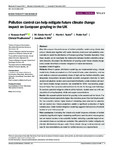Pollution control can help mitigate future climate change impact on European grayling in the UK
| dc.contributor.author | Huml, JV | |
| dc.contributor.author | Harris, WE | |
| dc.contributor.author | Taylor, MI | |
| dc.contributor.author | Sen, R | |
| dc.contributor.author | Prudhomme, C | |
| dc.contributor.author | Ellis, Jonathan | |
| dc.date.accessioned | 2020-02-01T21:05:38Z | |
| dc.date.available | 2020-02-01T21:05:38Z | |
| dc.date.issued | 2020-04 | |
| dc.identifier.issn | 1366-9516 | |
| dc.identifier.issn | 1472-4642 | |
| dc.identifier.other | 0 | |
| dc.identifier.uri | http://hdl.handle.net/10026.1/15351 | |
| dc.description.abstract |
<jats:title>Abstract</jats:title><jats:sec><jats:title>Aim</jats:title><jats:p>We compare the performance of habitat suitability models using climate data only or climate data together with water chemistry, land cover and predation pressure data to model the distribution of European grayling (<jats:italic>Thymallus thymallus</jats:italic>). From these models, we (a) investigate the relationship between habitat suitability and genetic diversity; (b) project the distribution of grayling under future climate change; and (c) model the effects of habitat mitigation on future distributions.</jats:p></jats:sec><jats:sec><jats:title>Location</jats:title><jats:p>United Kingdom.</jats:p></jats:sec><jats:sec><jats:title>Methods</jats:title><jats:p>Maxent species distribution modelling was implemented using a Simple model (only climate parameters) or a Full model (climate, water chemistry, land use and predation pressure parameters). Areas of high and low habitat suitability were designated. Associations between habitat suitability and genetic diversity for both neutral and adaptive markers were examined. Distribution under minimal and maximal future climate change scenarios was modelled for 2050, incorporating projections of future flow scenarios obtained from the Centre for Ecology and Hydrology. To examine potential mitigation effects within habitats, models were run with manipulation of orthophosphate, nitrite and copper concentrations.</jats:p></jats:sec><jats:sec><jats:title>Results</jats:title><jats:p>We mapped suitable habitat for grayling in the present and the future. The Full model achieved substantially higher discriminative power than the Simple model. For low suitability habitat, higher levels of inbreeding were observed for adaptive, but not neutral, loci. Future projections predict a significant contraction of highly suitable areas. Under habitat mitigation, modelling suggests that recovery of suitable habitat of up to 10% is possible.</jats:p></jats:sec><jats:sec><jats:title>Main conclusions</jats:title><jats:p>Extending the climate‐only model improves estimates of habitat suitability. Significantly higher inbreeding coefficients were found at immune genes, but not neutral markers in low suitability habitat, indicating a possible impact of environmental stress on evolutionary potential. The potential for habitat mitigation to alleviate distributional changes under future climate change is demonstrated, and specific recommendations are made for habitat recovery on a regional basis.</jats:p></jats:sec> | |
| dc.format.extent | 517-532 | |
| dc.language | en | |
| dc.language.iso | en | |
| dc.publisher | Wiley | |
| dc.subject | climate change | |
| dc.subject | conservation | |
| dc.subject | European grayling | |
| dc.subject | habitat improvement | |
| dc.subject | pollution | |
| dc.subject | species distribution modelling | |
| dc.title | Pollution control can help mitigate future climate change impact on European grayling in the UK | |
| dc.type | journal-article | |
| dc.type | Journal Article | |
| plymouth.author-url | https://www.webofscience.com/api/gateway?GWVersion=2&SrcApp=PARTNER_APP&SrcAuth=LinksAMR&KeyUT=WOS:000509906900001&DestLinkType=FullRecord&DestApp=ALL_WOS&UsrCustomerID=11bb513d99f797142bcfeffcc58ea008 | |
| plymouth.issue | 4 | |
| plymouth.volume | 26 | |
| plymouth.publication-status | Published | |
| plymouth.journal | Diversity and Distributions | |
| dc.identifier.doi | 10.1111/ddi.13039 | |
| plymouth.organisational-group | /Plymouth | |
| plymouth.organisational-group | /Plymouth/Faculty of Science and Engineering | |
| plymouth.organisational-group | /Plymouth/Faculty of Science and Engineering/School of Biological and Marine Sciences | |
| plymouth.organisational-group | /Plymouth/REF 2021 Researchers by UoA | |
| plymouth.organisational-group | /Plymouth/REF 2021 Researchers by UoA/UoA06 Agriculture, Veterinary and Food Science | |
| plymouth.organisational-group | /Plymouth/Users by role | |
| plymouth.organisational-group | /Plymouth/Users by role/Academics | |
| dcterms.dateAccepted | 2019-12-29 | |
| dc.rights.embargodate | 2020-3-7 | |
| dc.identifier.eissn | 1472-4642 | |
| dc.rights.embargoperiod | Not known | |
| rioxxterms.versionofrecord | 10.1111/ddi.13039 | |
| rioxxterms.licenseref.uri | http://www.rioxx.net/licenses/all-rights-reserved | |
| rioxxterms.type | Journal Article/Review |


